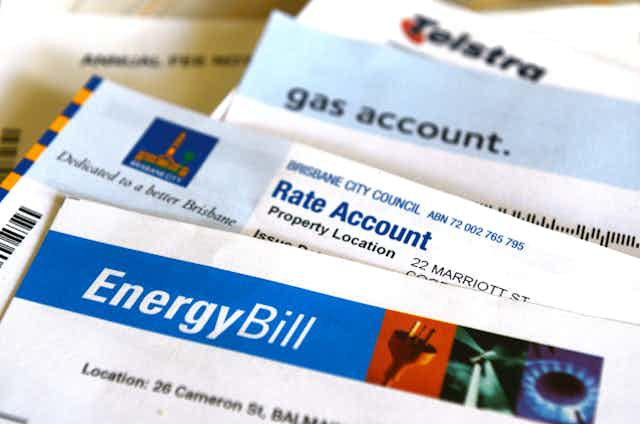Electricity bills are set to rise further for households, according to a report from the Australian Energy Markets Commission (AEMC).
The report, released this week to coincide with the December meeting of the COAG Energy Council, forecasts that electricity bills will increase by an average of A$78 by 2018 in the five eastern states and the ACT. Together these comprise the National Electricity Market (NEM).
The AEMC has prepared these three-year reports each year since 2010. But no report has received as much publicity as this one. This is largely because the latest report comes hard on the heels of the announcement that Victoria’s Hazelwood power station is to close – the largest power station closure ever in Australia.
It also follows the release of a specially commissioned report by Chief Scientist Alan Finkel that opens with the words: “The physical electricity system is undergoing its greatest transition since Nikola Tesla and Thomas Edison clashed in the War of the Currents in the early 1890s.”
So what does the latest report really say?
What’s the forecast?
The AEMC’s 2016 residential price report projects moderate increases in the average price paid by households in New South Wales, Victoria, South Australia and the ACT over the next two years, and moderate decreases in Queensland and Tasmania.
These overall movements result from the interaction of the three major cost components of the total cost of electricity supply.
The three components are:
the regulated network costs (transmission and distribution)
what the AEMC calls environmental costs (the large and small renewable energy targets, together with various state- and territory-specific programs), which are also set by regulation
what the AEMC calls competitive market costs, comprising wholesale market cost and retail margin.
This approach to estimating total prices was established in the 2010 report and has been fundamentally unchanged ever since. The sophistication and detail of the analysis have, however, increased considerably over the years.
The biggest factor affecting the prices projected in the 2016 report is the planned closure of Hazelwood next March. This is in addition to last May’s closure of the Northern power station in SA. These closures are particularly important for Victoria, SA and Tasmania.
State of the states
In Victoria, Tasmania and SA, a combination of Victorian brown coal and Tasmanian hydro and wind supplies most electricity traded in the wholesale market.
Gas is important in SA, but its cost has greatly increased because of higher gas wholesale prices. Demand peaks are supplied by gas plants and Snowy hydro.
Australia currently has more electricity capacity than demand. But the power station closures shift this much closer to balanced supply and demand. Consequently, wholesale prices are expected to increase and flow through to retail prices in Victoria and SA.
In Tasmania, large decreases in network costs, based on regulatory determinations already made by the Australian Energy Regulator, are expected to more than offset wholesale prices increases. Network costs in the other two states are expected to change little.
The Hazelwood closure will also affect NSW prices. The first consequence of reduced generation in Victoria will be a reduction, or even reversal, of the current strong overall south-to-north energy flow on the Victoria-NSW interconnection.
Low-cost brown coal generators in Victoria are often the marginal source of supply in the NSW market. This puts downward pressure on NSW wholesale prices (and also leaves significant spare coal-fired capacity in NSW for much of the time).
The removal of spare capacity in Victoria will mean that nearly all NSW supply will be sourced from higher-cost black coal generators within NSW. Spare capacity will be reduced and wholesale prices will therefore tend to increase.
Over the past couple of years Queensland has been the only state where demand for electricity has grown substantially (mainly because of electricity use in coal seam gasfields). That growth is now slowing and it is expected that the balance of supply and demand will remain much as it is now. Consequently, wholesale prices will remain relatively unchanged.
Network costs are also expected to stay roughly constant in both NSW and Queensland. The overall outcome projected by the AEMC is therefore a modest price increase in NSW and a small decrease in Queensland.
End of an era?
Stepping back from this state-by-state picture, what we see is the approaching end of an era of generation oversupply in the NEM, stretching back to the early 1990s.
This situation was originally caused by too many power stations being commissioned in the 1980s in NSW and Victoria. It was then prolonged by three factors:
the extension of the operating life of older coal-fired power stations well beyond that anticipated when they were built
the reduction and near-cessation of growth in demand for electricity
the construction of new renewable generation (mainly wind power) under the Renewable Energy Target (RET) legislation.
For most of this period, average wholesale prices in this oversupplied market have been well below the cost of new power stations. They are now expected to move gradually up towards that replacement cost level, when it will be economic to add more power stations to the market.
It is ironic that conservative voices who blame the RET for forcing coal-fired power stations to close are often the same voices who claim that higher electricity prices are forcing businesses to close and contributing to the cessation of demand growth.
If they had their way and there was no wind generation, and the Kurri Kurri and Point Henry aluminium smelters had not closed, then demand would have outstripped supply some years ago.
This would allow higher-cost power stations to be competitive, and wholesale prices would have already been at or above the levels projected by the AEMC in this report.
And what would have been the lowest-cost generation technology available (which hasn’t been competitive in the over-supplied market until now)? Based on the most recent data, probably wind.

